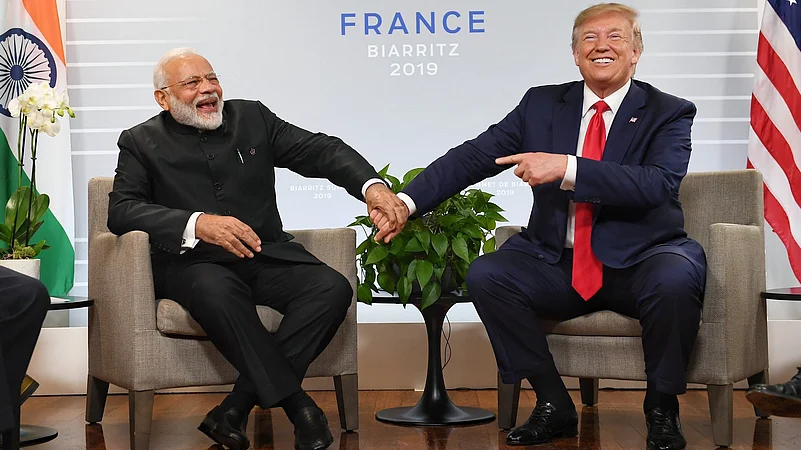

Modi-Trump, As India and the United States prepare for high-level talks between Prime Minister Narendra Modi and former U.S. President Donald Trump, trade relations between the two countries are once again under scrutiny. A major concern in these discussions is India’s high tariffs on various imported goods, which have been a point of contention for years. The U.S. has repeatedly criticized India’s protectionist trade policies, arguing that they create barriers for American businesses. Meanwhile, India maintains that these tariffs are necessary to support local industries and boost domestic economic growth. The upcoming meeting will likely address these issues, with both sides hoping to find common ground that benefits their respective economies.
1. The Impact of High Tariffs on U.S.-India Trade
Additionally, India’s high tariffs have long been a sticking point in trade relations with Modi-Trump. These tariffs make it more expensive for American products to enter the Indian market, reducing their competitiveness against locally manufactured goods. For example, high import duties on electronics, medical devices, and agricultural products have led to frustrations among U.S. exporters, who find it challenging to expand their presence in India. American businesses argue that these tariffs limit market access and restrict consumer choice in India.
On the other hand, India justifies its tariff policies by citing the need to protect domestic industries from foreign competition. Many Indian businesses, especially in manufacturing and agriculture, rely on government support to compete with large multinational corporations. The Modi-Trump government has also promoted the “Make in India” initiative, which encourages domestic production and self-reliance. While this approach has helped boost local industries, it has also led to trade tensions with the U.S., which sees these policies as a form of economic protectionism.
2. American Criticism of India’s Protectionist Policies
The U.S. has consistently criticized India’s trade policies, calling them restrictive and unfair. American officials argue that India’s high tariffs and regulatory barriers make it difficult for U.S. companies to do business in the country. Former President Donald Trump frequently expressed frustration over India’s trade practices, once calling the country the “tariff king.” He pointed out that India imposes higher duties on American products than the U.S. does on Indian exports, leading to a trade imbalance that favors India.
From India’s perspective, however, these tariffs are essential for maintaining economic stability and encouraging local manufacturing. India’s government believes that lowering tariffs too much could flood the market with foreign goods, harming small and medium-sized enterprises (SMEs). Modi-Trump, While India has made some efforts to reduce tariffs in certain sectors, the overall structure remains largely protective. The challenge for both countries is to strike a balance between protecting domestic interests and promoting fair trade.
3. The Effect on Bilateral Relations
Trade tensions over tariffs have occasionally strained diplomatic relations between India and the U.S. While both countries share strategic interests in areas like defense and technology, trade disagreements have sometimes overshadowed other aspects of their partnership. The Trump administration had taken a tough stance on India’s tariffs, removing India from the Generalized System of Preferences (GSP), which provided duty-free access to certain Indian exports. This move was seen as a response to India’s reluctance to lower its tariffs on Modi-Trump goods.
Despite these tensions, the U.S. and India have continued to engage in trade negotiations. The Biden administration has also pushed for greater market access for American companies in India. While both nations recognize the importance of their economic relationship, resolving trade disputes remains a challenging task. The upcoming Modi-Trump meeting provides an opportunity to address these concerns and work toward a more balanced trade agreement.
4. The Role of Domestic Politics in Trade Policies
India’s tariff policies are heavily influenced by domestic economic and political factors. The Modi-Trump government has prioritized economic self-sufficiency, particularly through initiatives like “Atmanirbhar Bharat” (Self-Reliant India). This policy aims to reduce dependence on imports and promote local production, which is why the government has been reluctant to lower tariffs on foreign goods. With elections always on the horizon, policymakers also consider the impact of trade policies on local industries and employment.
Similarly,Modi-Trump, in the U.S., trade policies are shaped by domestic political considerations. American leaders, regardless of party affiliation, often advocate for fairer trade deals that benefit American workers and businesses. While some U.S. policymakers support stronger trade ties with India, others push for tougher measures to counter what they see as unfair trade practices. Balancing these competing interests makes it difficult to reach a trade deal that satisfies both sides.
5. Possible Compromises and Trade Agreements
To ease tensions, both India and the U.S. have explored potential trade agreements that could provide benefits to both countries. One possible solution is a limited trade deal that reduces tariffs on select products while maintaining protections for sensitive industries. Such agreements could include lower tariffs on American agricultural products and medical devices in exchange for increased market access for Indian goods in the U.S.
Another approach could involve strengthening investment and technology-sharing agreements. The Modi-Trump have already collaborated on defense and technology projects, and expanding these partnerships could help mitigate trade disputes. If both sides are willing to compromise, a mutually beneficial agreement could be reached that addresses key concerns without completely dismantling India’s protectionist policies.
6. The Future of U.S.-India Trade Relations
The upcoming Modi-Trump meeting will be crucial in determining the future of U.S.-India trade relations. While both countries have strong economic ties, unresolved trade disputes continue to create friction. The U.S. will likely push for lower tariffs and greater market access, while India will seek assurances that its domestic industries will not be negatively impacted by trade liberalization.
Ultimately, the success of trade negotiations will depend on the willingness of both countries to find common ground. If India and the U.S. can work out a fair trade agreement, it could pave the way for a stronger economic partnership. However, if differences persist, trade tensions could continue to strain relations. Regardless of the outcome, trade will remain a central issue in U.S.-India diplomacy for the foreseeable future.
Buy Domin and hosting with our trusted websites
https://www.hostinger.in/
https://www.bluehost.com/
Visit our Website
https://spotself.com/




Leave a Reply